Advanced Organizational Behavior Report: Company A Analysis
VerifiedAdded on 2020/03/23
|13
|2644
|74
Report
AI Summary
This report provides a comprehensive analysis of organizational behavior issues at Company A, an IT consulting firm. It examines challenges related to employee motivation, leadership, and organizational culture, particularly focusing on the impact of low wages, authoritarian leadership styles, and gender discrimination. The report utilizes organizational behavior theories to analyze these issues and proposes recommendations, including raising employee wages, establishing two-way communication, fostering an organic culture, and implementing anti-discrimination policies. The conclusion emphasizes the need for Company A to re-orient its management structure to address labor unrest, enhance employee motivation, and promote a more constructive and equitable organizational culture. The report highlights the importance of addressing employee needs, redesigning reward programs, and eradicating gender discrimination to improve overall performance and create a positive work environment.
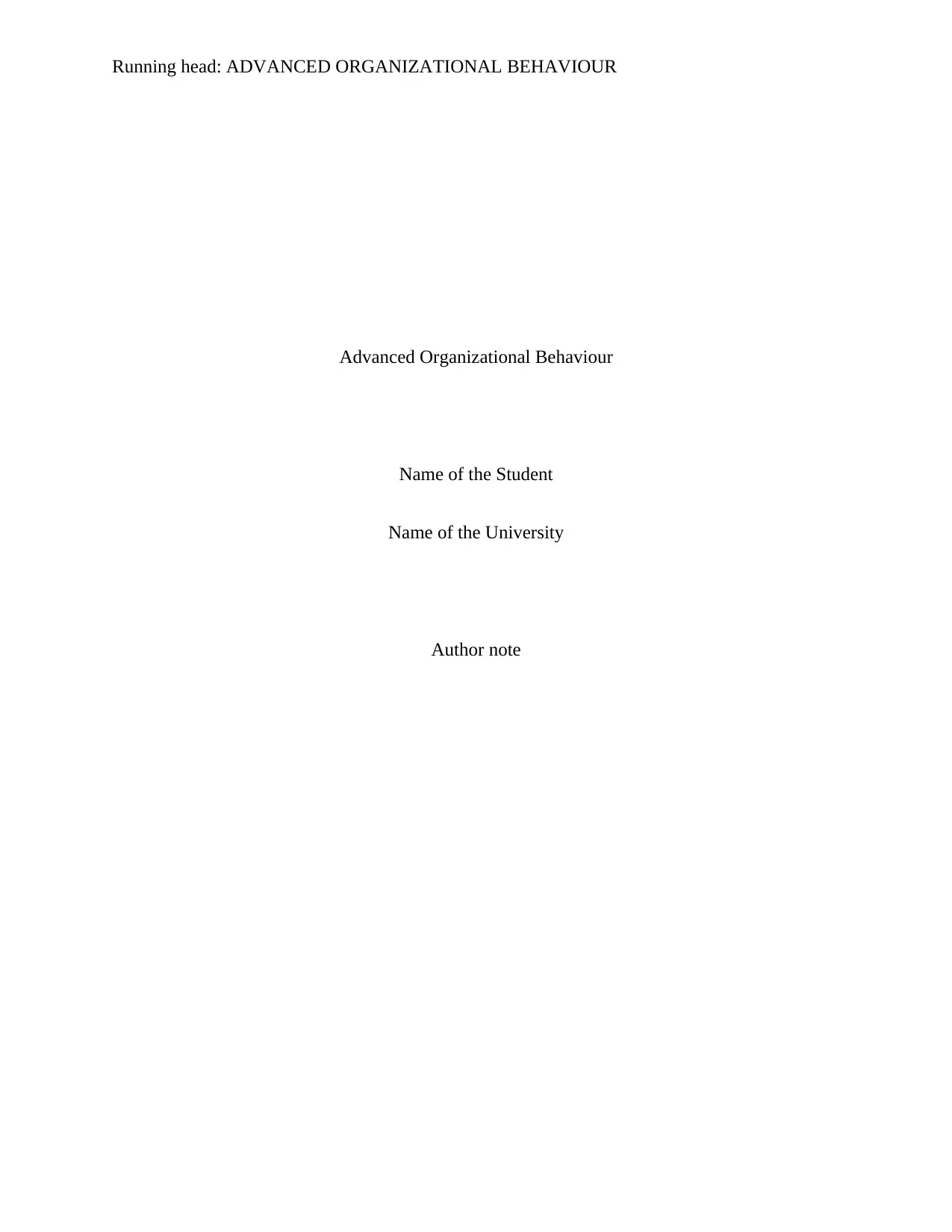
Running head: ADVANCED ORGANIZATIONAL BEHAVIOUR
Advanced Organizational Behaviour
Name of the Student
Name of the University
Author note
Advanced Organizational Behaviour
Name of the Student
Name of the University
Author note
Paraphrase This Document
Need a fresh take? Get an instant paraphrase of this document with our AI Paraphraser
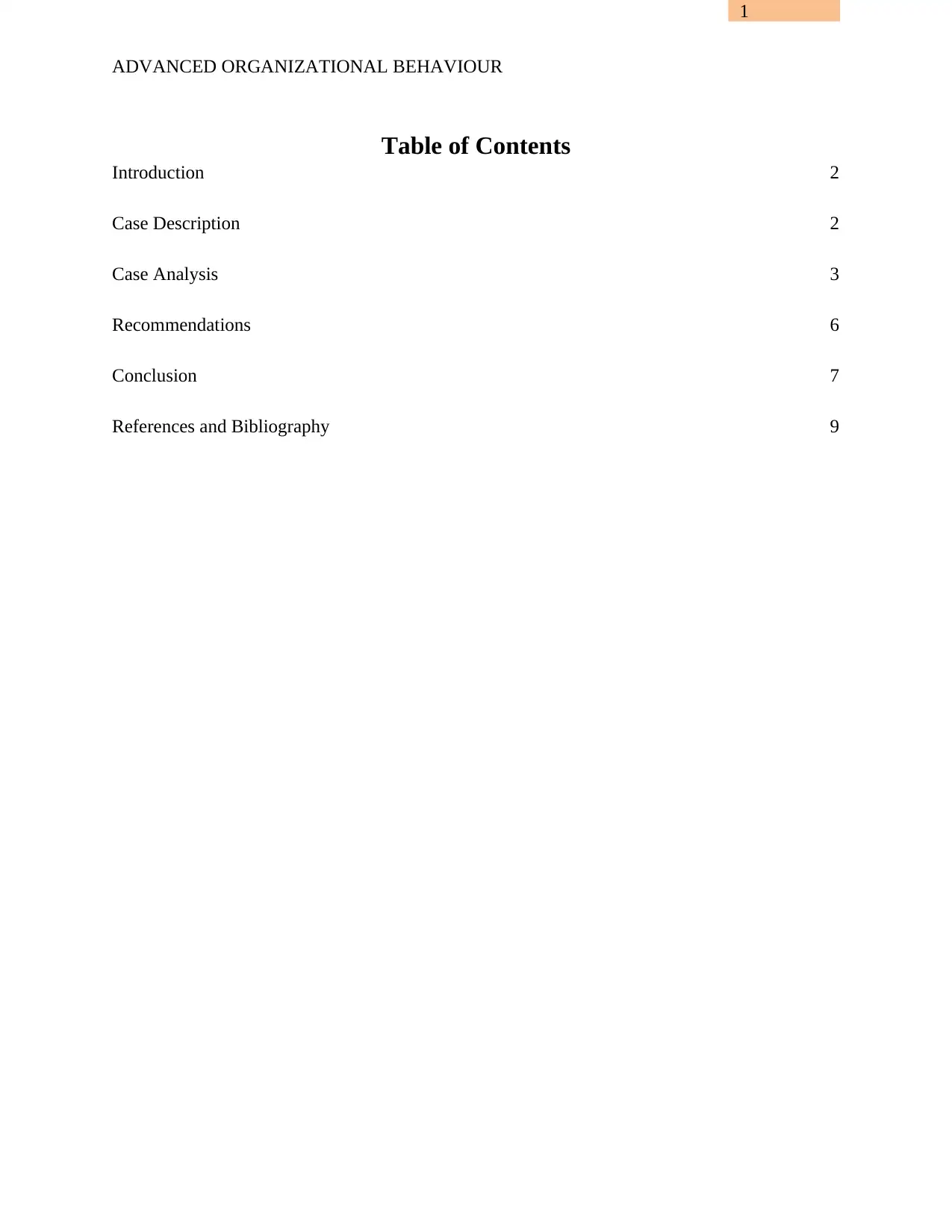
1
ADVANCED ORGANIZATIONAL BEHAVIOUR
Table of Contents
Introduction 2
Case Description 2
Case Analysis 3
Recommendations 6
Conclusion 7
References and Bibliography 9
ADVANCED ORGANIZATIONAL BEHAVIOUR
Table of Contents
Introduction 2
Case Description 2
Case Analysis 3
Recommendations 6
Conclusion 7
References and Bibliography 9
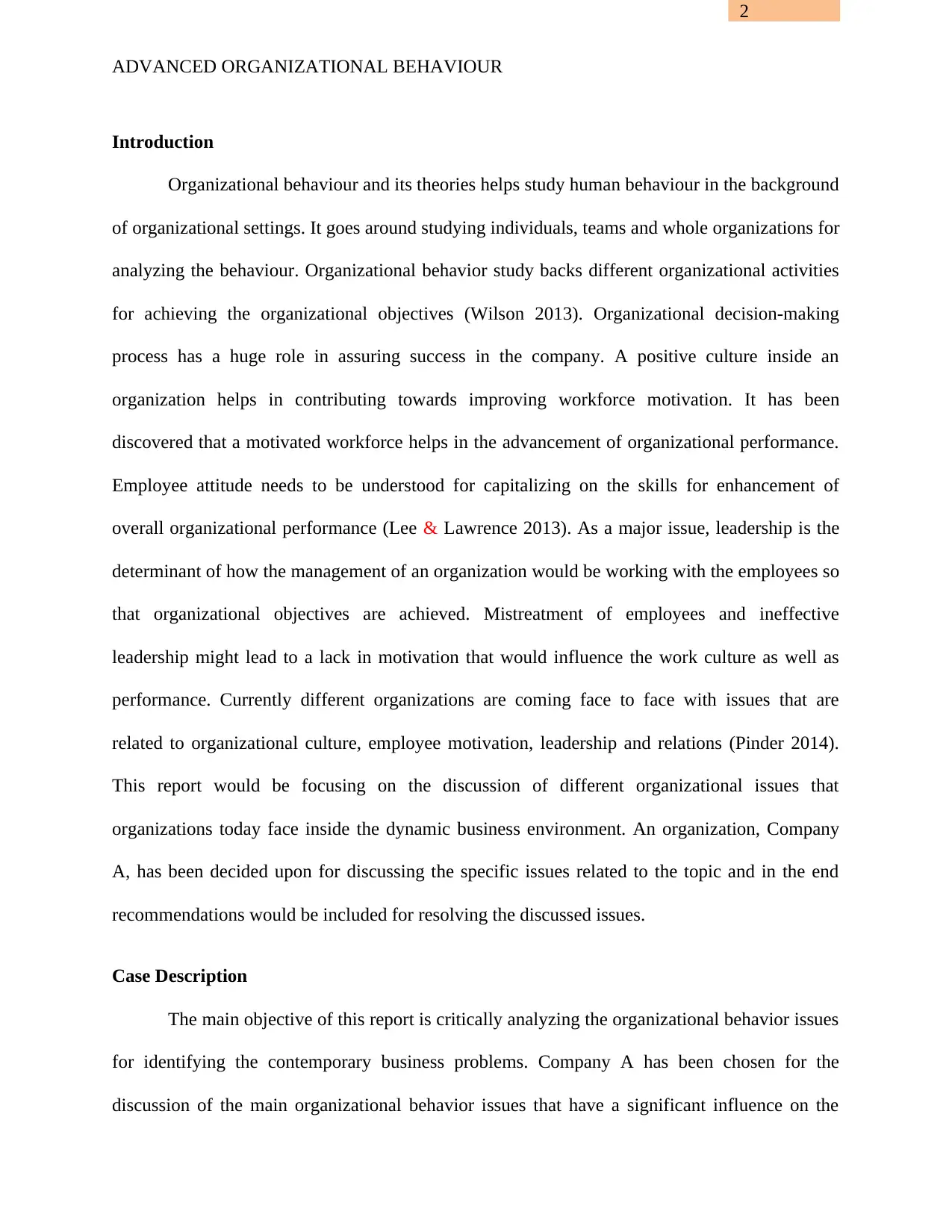
2
ADVANCED ORGANIZATIONAL BEHAVIOUR
Introduction
Organizational behaviour and its theories helps study human behaviour in the background
of organizational settings. It goes around studying individuals, teams and whole organizations for
analyzing the behaviour. Organizational behavior study backs different organizational activities
for achieving the organizational objectives (Wilson 2013). Organizational decision-making
process has a huge role in assuring success in the company. A positive culture inside an
organization helps in contributing towards improving workforce motivation. It has been
discovered that a motivated workforce helps in the advancement of organizational performance.
Employee attitude needs to be understood for capitalizing on the skills for enhancement of
overall organizational performance (Lee & Lawrence 2013). As a major issue, leadership is the
determinant of how the management of an organization would be working with the employees so
that organizational objectives are achieved. Mistreatment of employees and ineffective
leadership might lead to a lack in motivation that would influence the work culture as well as
performance. Currently different organizations are coming face to face with issues that are
related to organizational culture, employee motivation, leadership and relations (Pinder 2014).
This report would be focusing on the discussion of different organizational issues that
organizations today face inside the dynamic business environment. An organization, Company
A, has been decided upon for discussing the specific issues related to the topic and in the end
recommendations would be included for resolving the discussed issues.
Case Description
The main objective of this report is critically analyzing the organizational behavior issues
for identifying the contemporary business problems. Company A has been chosen for the
discussion of the main organizational behavior issues that have a significant influence on the
ADVANCED ORGANIZATIONAL BEHAVIOUR
Introduction
Organizational behaviour and its theories helps study human behaviour in the background
of organizational settings. It goes around studying individuals, teams and whole organizations for
analyzing the behaviour. Organizational behavior study backs different organizational activities
for achieving the organizational objectives (Wilson 2013). Organizational decision-making
process has a huge role in assuring success in the company. A positive culture inside an
organization helps in contributing towards improving workforce motivation. It has been
discovered that a motivated workforce helps in the advancement of organizational performance.
Employee attitude needs to be understood for capitalizing on the skills for enhancement of
overall organizational performance (Lee & Lawrence 2013). As a major issue, leadership is the
determinant of how the management of an organization would be working with the employees so
that organizational objectives are achieved. Mistreatment of employees and ineffective
leadership might lead to a lack in motivation that would influence the work culture as well as
performance. Currently different organizations are coming face to face with issues that are
related to organizational culture, employee motivation, leadership and relations (Pinder 2014).
This report would be focusing on the discussion of different organizational issues that
organizations today face inside the dynamic business environment. An organization, Company
A, has been decided upon for discussing the specific issues related to the topic and in the end
recommendations would be included for resolving the discussed issues.
Case Description
The main objective of this report is critically analyzing the organizational behavior issues
for identifying the contemporary business problems. Company A has been chosen for the
discussion of the main organizational behavior issues that have a significant influence on the
⊘ This is a preview!⊘
Do you want full access?
Subscribe today to unlock all pages.

Trusted by 1+ million students worldwide
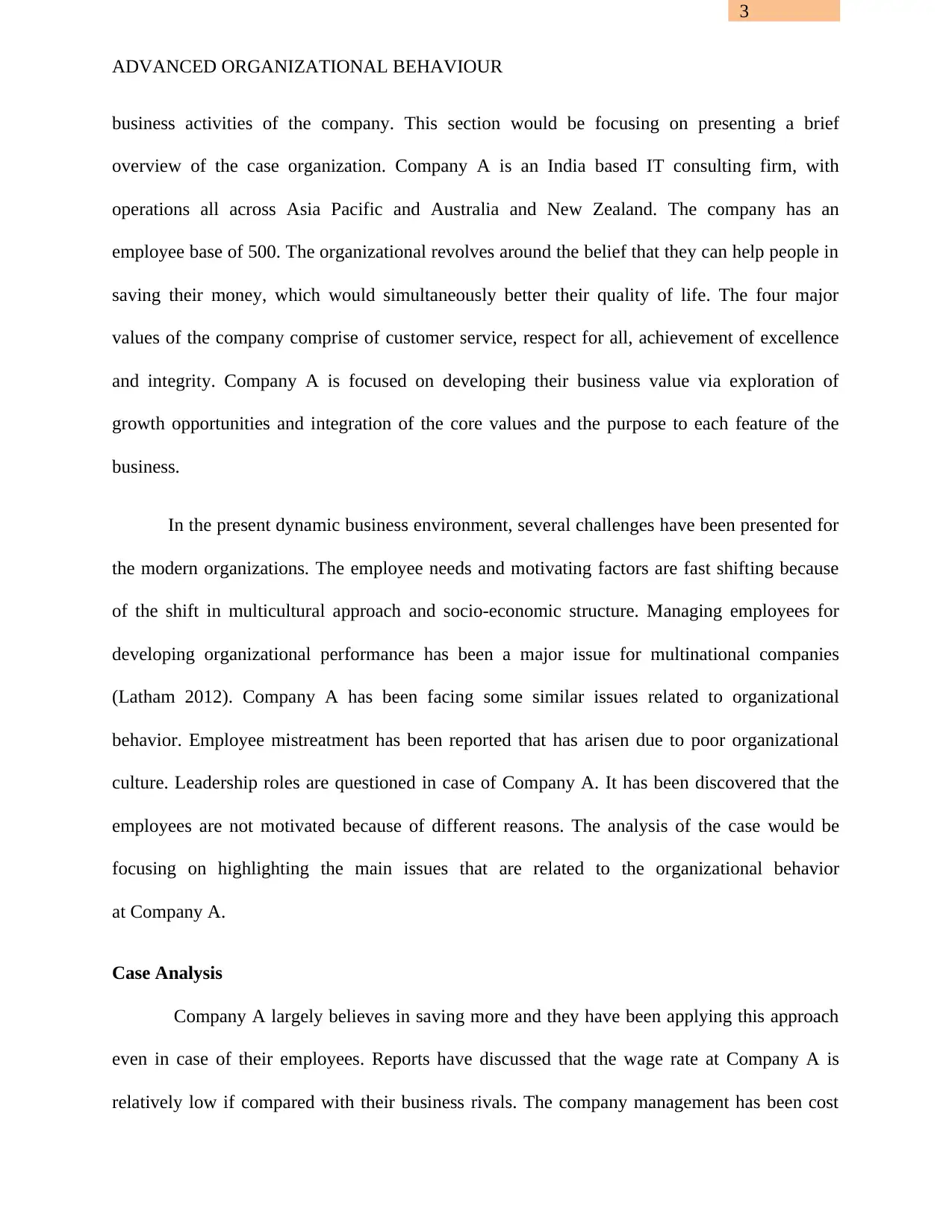
3
ADVANCED ORGANIZATIONAL BEHAVIOUR
business activities of the company. This section would be focusing on presenting a brief
overview of the case organization. Company A is an India based IT consulting firm, with
operations all across Asia Pacific and Australia and New Zealand. The company has an
employee base of 500. The organizational revolves around the belief that they can help people in
saving their money, which would simultaneously better their quality of life. The four major
values of the company comprise of customer service, respect for all, achievement of excellence
and integrity. Company A is focused on developing their business value via exploration of
growth opportunities and integration of the core values and the purpose to each feature of the
business.
In the present dynamic business environment, several challenges have been presented for
the modern organizations. The employee needs and motivating factors are fast shifting because
of the shift in multicultural approach and socio-economic structure. Managing employees for
developing organizational performance has been a major issue for multinational companies
(Latham 2012). Company A has been facing some similar issues related to organizational
behavior. Employee mistreatment has been reported that has arisen due to poor organizational
culture. Leadership roles are questioned in case of Company A. It has been discovered that the
employees are not motivated because of different reasons. The analysis of the case would be
focusing on highlighting the main issues that are related to the organizational behavior
at Company A.
Case Analysis
Company A largely believes in saving more and they have been applying this approach
even in case of their employees. Reports have discussed that the wage rate at Company A is
relatively low if compared with their business rivals. The company management has been cost
ADVANCED ORGANIZATIONAL BEHAVIOUR
business activities of the company. This section would be focusing on presenting a brief
overview of the case organization. Company A is an India based IT consulting firm, with
operations all across Asia Pacific and Australia and New Zealand. The company has an
employee base of 500. The organizational revolves around the belief that they can help people in
saving their money, which would simultaneously better their quality of life. The four major
values of the company comprise of customer service, respect for all, achievement of excellence
and integrity. Company A is focused on developing their business value via exploration of
growth opportunities and integration of the core values and the purpose to each feature of the
business.
In the present dynamic business environment, several challenges have been presented for
the modern organizations. The employee needs and motivating factors are fast shifting because
of the shift in multicultural approach and socio-economic structure. Managing employees for
developing organizational performance has been a major issue for multinational companies
(Latham 2012). Company A has been facing some similar issues related to organizational
behavior. Employee mistreatment has been reported that has arisen due to poor organizational
culture. Leadership roles are questioned in case of Company A. It has been discovered that the
employees are not motivated because of different reasons. The analysis of the case would be
focusing on highlighting the main issues that are related to the organizational behavior
at Company A.
Case Analysis
Company A largely believes in saving more and they have been applying this approach
even in case of their employees. Reports have discussed that the wage rate at Company A is
relatively low if compared with their business rivals. The company management has been cost
Paraphrase This Document
Need a fresh take? Get an instant paraphrase of this document with our AI Paraphraser
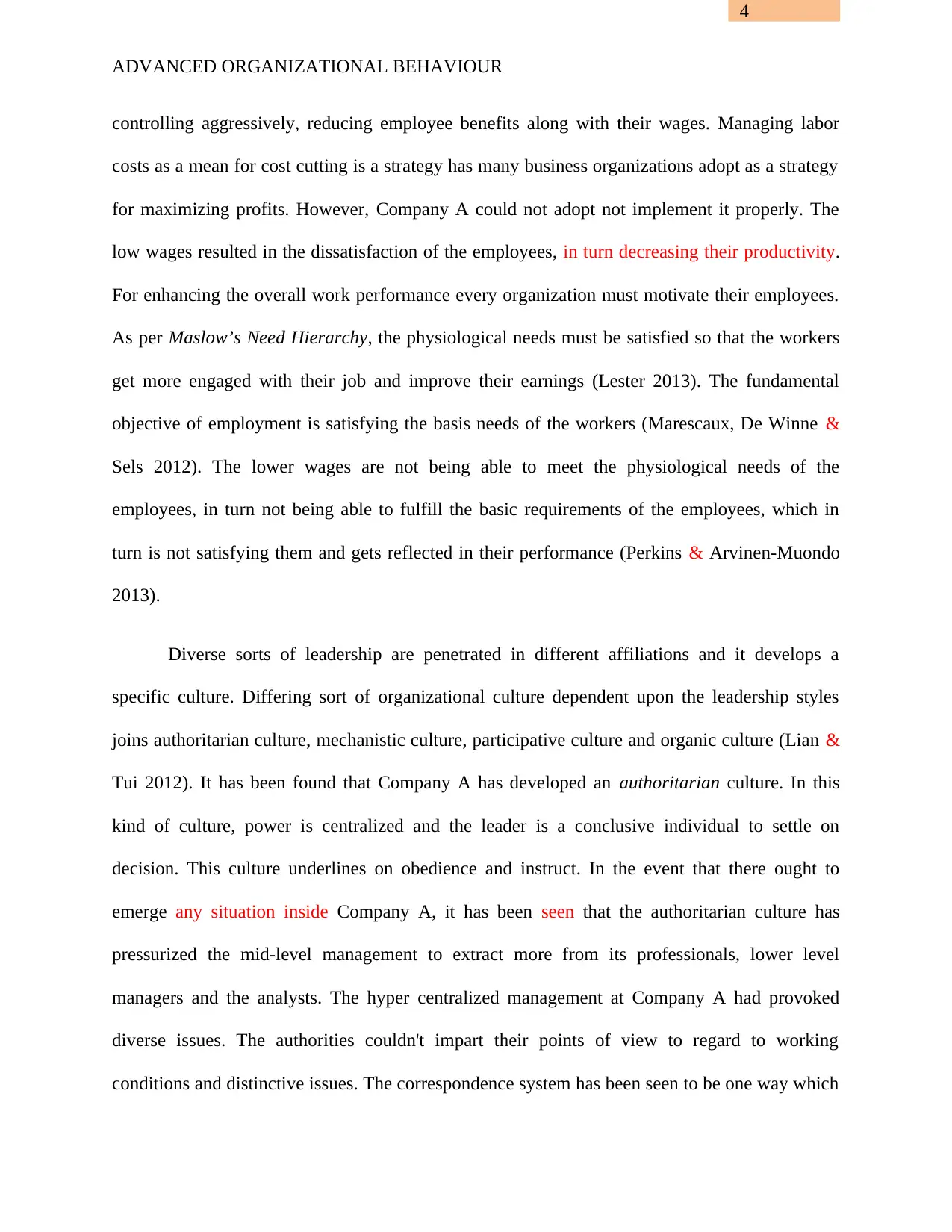
4
ADVANCED ORGANIZATIONAL BEHAVIOUR
controlling aggressively, reducing employee benefits along with their wages. Managing labor
costs as a mean for cost cutting is a strategy has many business organizations adopt as a strategy
for maximizing profits. However, Company A could not adopt not implement it properly. The
low wages resulted in the dissatisfaction of the employees, in turn decreasing their productivity.
For enhancing the overall work performance every organization must motivate their employees.
As per Maslow’s Need Hierarchy, the physiological needs must be satisfied so that the workers
get more engaged with their job and improve their earnings (Lester 2013). The fundamental
objective of employment is satisfying the basis needs of the workers (Marescaux, De Winne &
Sels 2012). The lower wages are not being able to meet the physiological needs of the
employees, in turn not being able to fulfill the basic requirements of the employees, which in
turn is not satisfying them and gets reflected in their performance (Perkins & Arvinen-Muondo
2013).
Diverse sorts of leadership are penetrated in different affiliations and it develops a
specific culture. Differing sort of organizational culture dependent upon the leadership styles
joins authoritarian culture, mechanistic culture, participative culture and organic culture (Lian &
Tui 2012). It has been found that Company A has developed an authoritarian culture. In this
kind of culture, power is centralized and the leader is a conclusive individual to settle on
decision. This culture underlines on obedience and instruct. In the event that there ought to
emerge any situation inside Company A, it has been seen that the authoritarian culture has
pressurized the mid-level management to extract more from its professionals, lower level
managers and the analysts. The hyper centralized management at Company A had provoked
diverse issues. The authorities couldn't impart their points of view to regard to working
conditions and distinctive issues. The correspondence system has been seen to be one way which
ADVANCED ORGANIZATIONAL BEHAVIOUR
controlling aggressively, reducing employee benefits along with their wages. Managing labor
costs as a mean for cost cutting is a strategy has many business organizations adopt as a strategy
for maximizing profits. However, Company A could not adopt not implement it properly. The
low wages resulted in the dissatisfaction of the employees, in turn decreasing their productivity.
For enhancing the overall work performance every organization must motivate their employees.
As per Maslow’s Need Hierarchy, the physiological needs must be satisfied so that the workers
get more engaged with their job and improve their earnings (Lester 2013). The fundamental
objective of employment is satisfying the basis needs of the workers (Marescaux, De Winne &
Sels 2012). The lower wages are not being able to meet the physiological needs of the
employees, in turn not being able to fulfill the basic requirements of the employees, which in
turn is not satisfying them and gets reflected in their performance (Perkins & Arvinen-Muondo
2013).
Diverse sorts of leadership are penetrated in different affiliations and it develops a
specific culture. Differing sort of organizational culture dependent upon the leadership styles
joins authoritarian culture, mechanistic culture, participative culture and organic culture (Lian &
Tui 2012). It has been found that Company A has developed an authoritarian culture. In this
kind of culture, power is centralized and the leader is a conclusive individual to settle on
decision. This culture underlines on obedience and instruct. In the event that there ought to
emerge any situation inside Company A, it has been seen that the authoritarian culture has
pressurized the mid-level management to extract more from its professionals, lower level
managers and the analysts. The hyper centralized management at Company A had provoked
diverse issues. The authorities couldn't impart their points of view to regard to working
conditions and distinctive issues. The correspondence system has been seen to be one way which
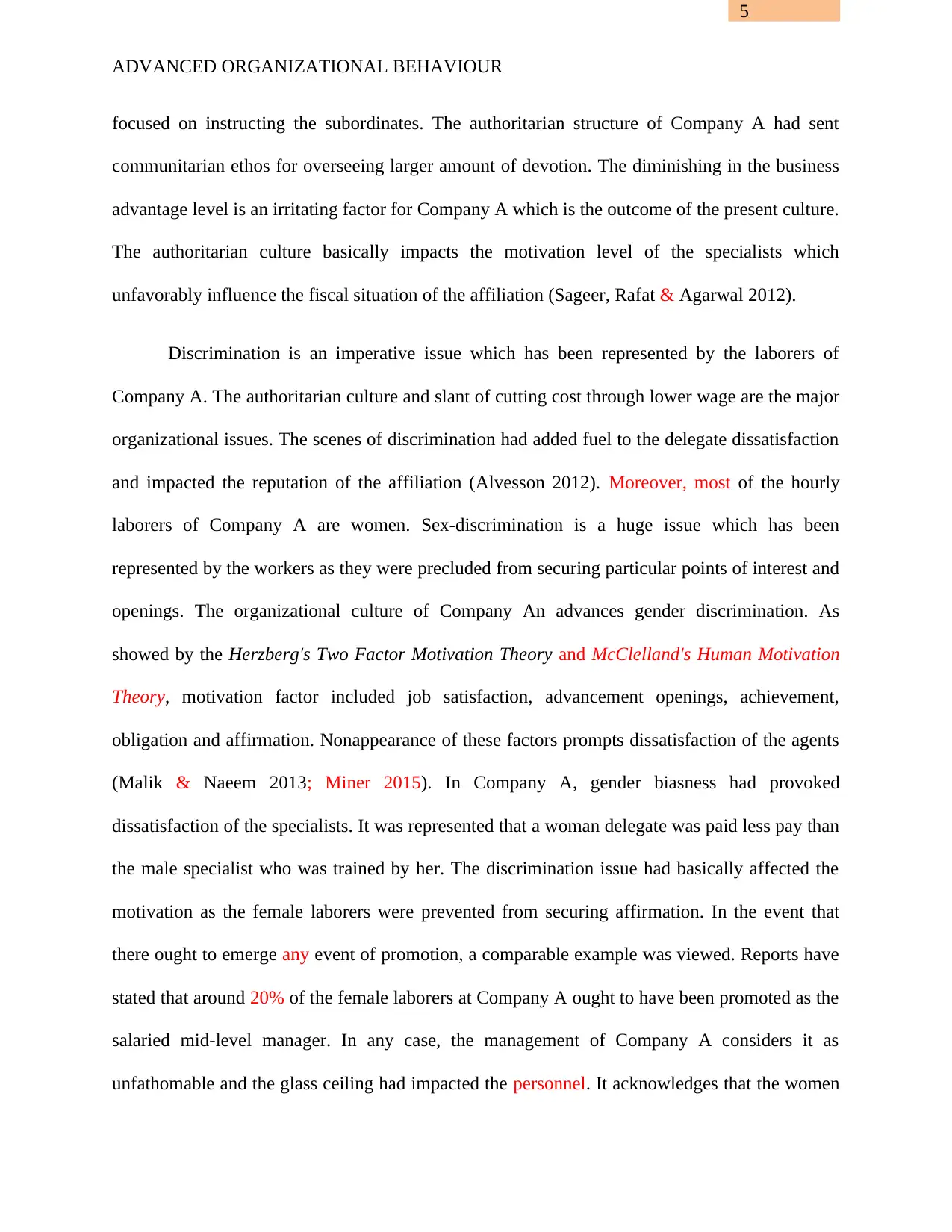
5
ADVANCED ORGANIZATIONAL BEHAVIOUR
focused on instructing the subordinates. The authoritarian structure of Company A had sent
communitarian ethos for overseeing larger amount of devotion. The diminishing in the business
advantage level is an irritating factor for Company A which is the outcome of the present culture.
The authoritarian culture basically impacts the motivation level of the specialists which
unfavorably influence the fiscal situation of the affiliation (Sageer, Rafat & Agarwal 2012).
Discrimination is an imperative issue which has been represented by the laborers of
Company A. The authoritarian culture and slant of cutting cost through lower wage are the major
organizational issues. The scenes of discrimination had added fuel to the delegate dissatisfaction
and impacted the reputation of the affiliation (Alvesson 2012). Moreover, most of the hourly
laborers of Company A are women. Sex-discrimination is a huge issue which has been
represented by the workers as they were precluded from securing particular points of interest and
openings. The organizational culture of Company An advances gender discrimination. As
showed by the Herzberg's Two Factor Motivation Theory and McClelland's Human Motivation
Theory, motivation factor included job satisfaction, advancement openings, achievement,
obligation and affirmation. Nonappearance of these factors prompts dissatisfaction of the agents
(Malik & Naeem 2013; Miner 2015). In Company A, gender biasness had provoked
dissatisfaction of the specialists. It was represented that a woman delegate was paid less pay than
the male specialist who was trained by her. The discrimination issue had basically affected the
motivation as the female laborers were prevented from securing affirmation. In the event that
there ought to emerge any event of promotion, a comparable example was viewed. Reports have
stated that around 20% of the female laborers at Company A ought to have been promoted as the
salaried mid-level manager. In any case, the management of Company A considers it as
unfathomable and the glass ceiling had impacted the personnel. It acknowledges that the women
ADVANCED ORGANIZATIONAL BEHAVIOUR
focused on instructing the subordinates. The authoritarian structure of Company A had sent
communitarian ethos for overseeing larger amount of devotion. The diminishing in the business
advantage level is an irritating factor for Company A which is the outcome of the present culture.
The authoritarian culture basically impacts the motivation level of the specialists which
unfavorably influence the fiscal situation of the affiliation (Sageer, Rafat & Agarwal 2012).
Discrimination is an imperative issue which has been represented by the laborers of
Company A. The authoritarian culture and slant of cutting cost through lower wage are the major
organizational issues. The scenes of discrimination had added fuel to the delegate dissatisfaction
and impacted the reputation of the affiliation (Alvesson 2012). Moreover, most of the hourly
laborers of Company A are women. Sex-discrimination is a huge issue which has been
represented by the workers as they were precluded from securing particular points of interest and
openings. The organizational culture of Company An advances gender discrimination. As
showed by the Herzberg's Two Factor Motivation Theory and McClelland's Human Motivation
Theory, motivation factor included job satisfaction, advancement openings, achievement,
obligation and affirmation. Nonappearance of these factors prompts dissatisfaction of the agents
(Malik & Naeem 2013; Miner 2015). In Company A, gender biasness had provoked
dissatisfaction of the specialists. It was represented that a woman delegate was paid less pay than
the male specialist who was trained by her. The discrimination issue had basically affected the
motivation as the female laborers were prevented from securing affirmation. In the event that
there ought to emerge any event of promotion, a comparable example was viewed. Reports have
stated that around 20% of the female laborers at Company A ought to have been promoted as the
salaried mid-level manager. In any case, the management of Company A considers it as
unfathomable and the glass ceiling had impacted the personnel. It acknowledges that the women
⊘ This is a preview!⊘
Do you want full access?
Subscribe today to unlock all pages.

Trusted by 1+ million students worldwide
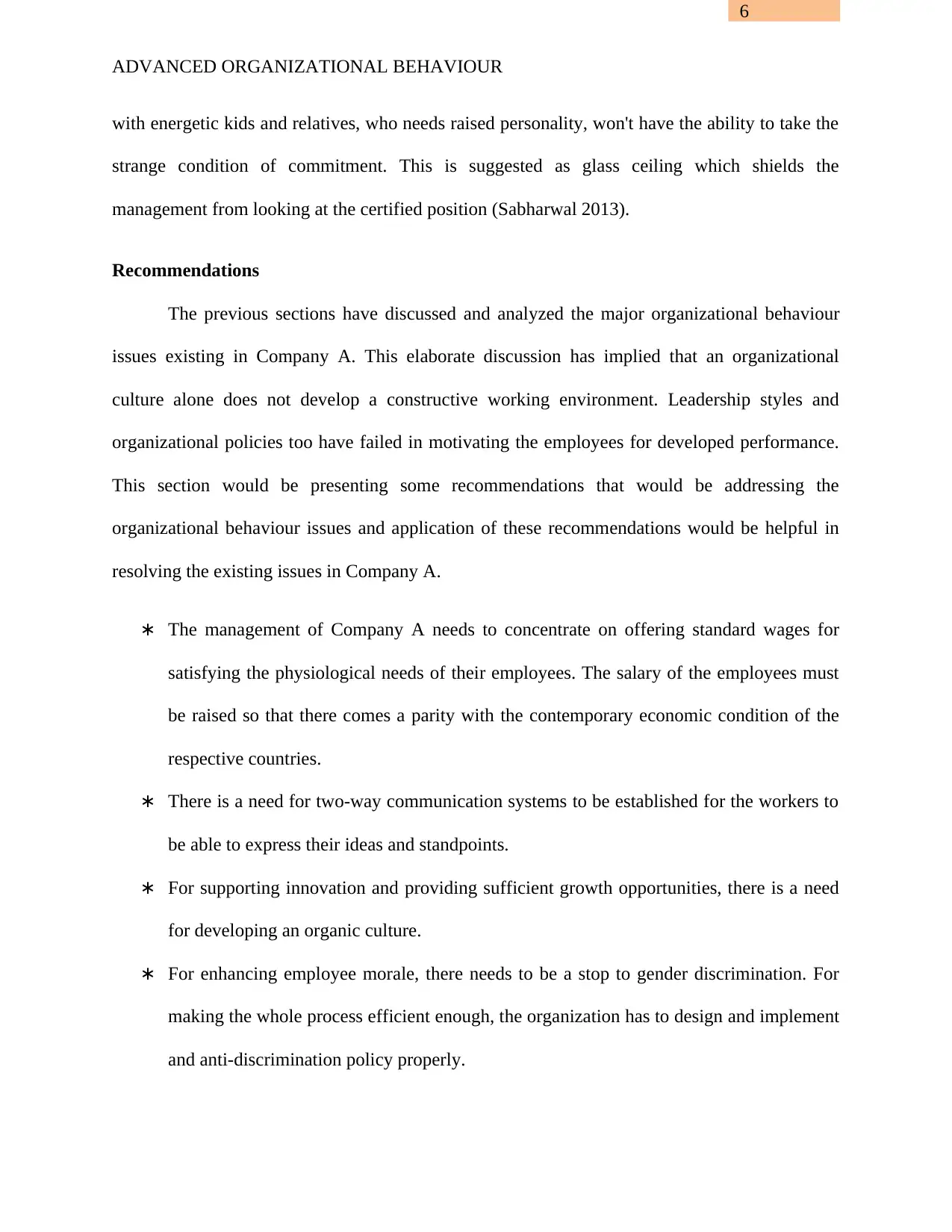
6
ADVANCED ORGANIZATIONAL BEHAVIOUR
with energetic kids and relatives, who needs raised personality, won't have the ability to take the
strange condition of commitment. This is suggested as glass ceiling which shields the
management from looking at the certified position (Sabharwal 2013).
Recommendations
The previous sections have discussed and analyzed the major organizational behaviour
issues existing in Company A. This elaborate discussion has implied that an organizational
culture alone does not develop a constructive working environment. Leadership styles and
organizational policies too have failed in motivating the employees for developed performance.
This section would be presenting some recommendations that would be addressing the
organizational behaviour issues and application of these recommendations would be helpful in
resolving the existing issues in Company A.
∗ The management of Company A needs to concentrate on offering standard wages for
satisfying the physiological needs of their employees. The salary of the employees must
be raised so that there comes a parity with the contemporary economic condition of the
respective countries.
∗ There is a need for two-way communication systems to be established for the workers to
be able to express their ideas and standpoints.
∗ For supporting innovation and providing sufficient growth opportunities, there is a need
for developing an organic culture.
∗ For enhancing employee morale, there needs to be a stop to gender discrimination. For
making the whole process efficient enough, the organization has to design and implement
and anti-discrimination policy properly.
ADVANCED ORGANIZATIONAL BEHAVIOUR
with energetic kids and relatives, who needs raised personality, won't have the ability to take the
strange condition of commitment. This is suggested as glass ceiling which shields the
management from looking at the certified position (Sabharwal 2013).
Recommendations
The previous sections have discussed and analyzed the major organizational behaviour
issues existing in Company A. This elaborate discussion has implied that an organizational
culture alone does not develop a constructive working environment. Leadership styles and
organizational policies too have failed in motivating the employees for developed performance.
This section would be presenting some recommendations that would be addressing the
organizational behaviour issues and application of these recommendations would be helpful in
resolving the existing issues in Company A.
∗ The management of Company A needs to concentrate on offering standard wages for
satisfying the physiological needs of their employees. The salary of the employees must
be raised so that there comes a parity with the contemporary economic condition of the
respective countries.
∗ There is a need for two-way communication systems to be established for the workers to
be able to express their ideas and standpoints.
∗ For supporting innovation and providing sufficient growth opportunities, there is a need
for developing an organic culture.
∗ For enhancing employee morale, there needs to be a stop to gender discrimination. For
making the whole process efficient enough, the organization has to design and implement
and anti-discrimination policy properly.
Paraphrase This Document
Need a fresh take? Get an instant paraphrase of this document with our AI Paraphraser
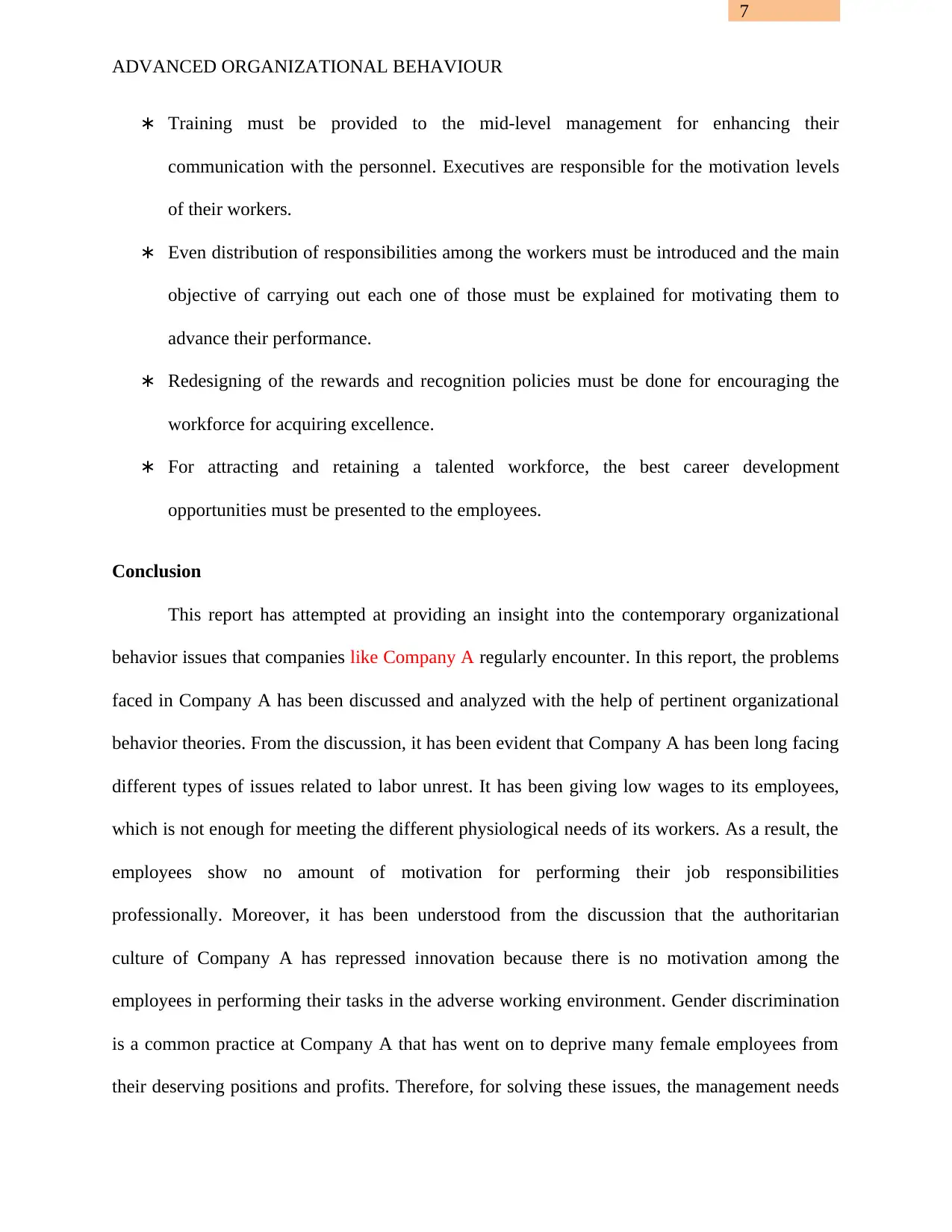
7
ADVANCED ORGANIZATIONAL BEHAVIOUR
∗ Training must be provided to the mid-level management for enhancing their
communication with the personnel. Executives are responsible for the motivation levels
of their workers.
∗ Even distribution of responsibilities among the workers must be introduced and the main
objective of carrying out each one of those must be explained for motivating them to
advance their performance.
∗ Redesigning of the rewards and recognition policies must be done for encouraging the
workforce for acquiring excellence.
∗ For attracting and retaining a talented workforce, the best career development
opportunities must be presented to the employees.
Conclusion
This report has attempted at providing an insight into the contemporary organizational
behavior issues that companies like Company A regularly encounter. In this report, the problems
faced in Company A has been discussed and analyzed with the help of pertinent organizational
behavior theories. From the discussion, it has been evident that Company A has been long facing
different types of issues related to labor unrest. It has been giving low wages to its employees,
which is not enough for meeting the different physiological needs of its workers. As a result, the
employees show no amount of motivation for performing their job responsibilities
professionally. Moreover, it has been understood from the discussion that the authoritarian
culture of Company A has repressed innovation because there is no motivation among the
employees in performing their tasks in the adverse working environment. Gender discrimination
is a common practice at Company A that has went on to deprive many female employees from
their deserving positions and profits. Therefore, for solving these issues, the management needs
ADVANCED ORGANIZATIONAL BEHAVIOUR
∗ Training must be provided to the mid-level management for enhancing their
communication with the personnel. Executives are responsible for the motivation levels
of their workers.
∗ Even distribution of responsibilities among the workers must be introduced and the main
objective of carrying out each one of those must be explained for motivating them to
advance their performance.
∗ Redesigning of the rewards and recognition policies must be done for encouraging the
workforce for acquiring excellence.
∗ For attracting and retaining a talented workforce, the best career development
opportunities must be presented to the employees.
Conclusion
This report has attempted at providing an insight into the contemporary organizational
behavior issues that companies like Company A regularly encounter. In this report, the problems
faced in Company A has been discussed and analyzed with the help of pertinent organizational
behavior theories. From the discussion, it has been evident that Company A has been long facing
different types of issues related to labor unrest. It has been giving low wages to its employees,
which is not enough for meeting the different physiological needs of its workers. As a result, the
employees show no amount of motivation for performing their job responsibilities
professionally. Moreover, it has been understood from the discussion that the authoritarian
culture of Company A has repressed innovation because there is no motivation among the
employees in performing their tasks in the adverse working environment. Gender discrimination
is a common practice at Company A that has went on to deprive many female employees from
their deserving positions and profits. Therefore, for solving these issues, the management needs
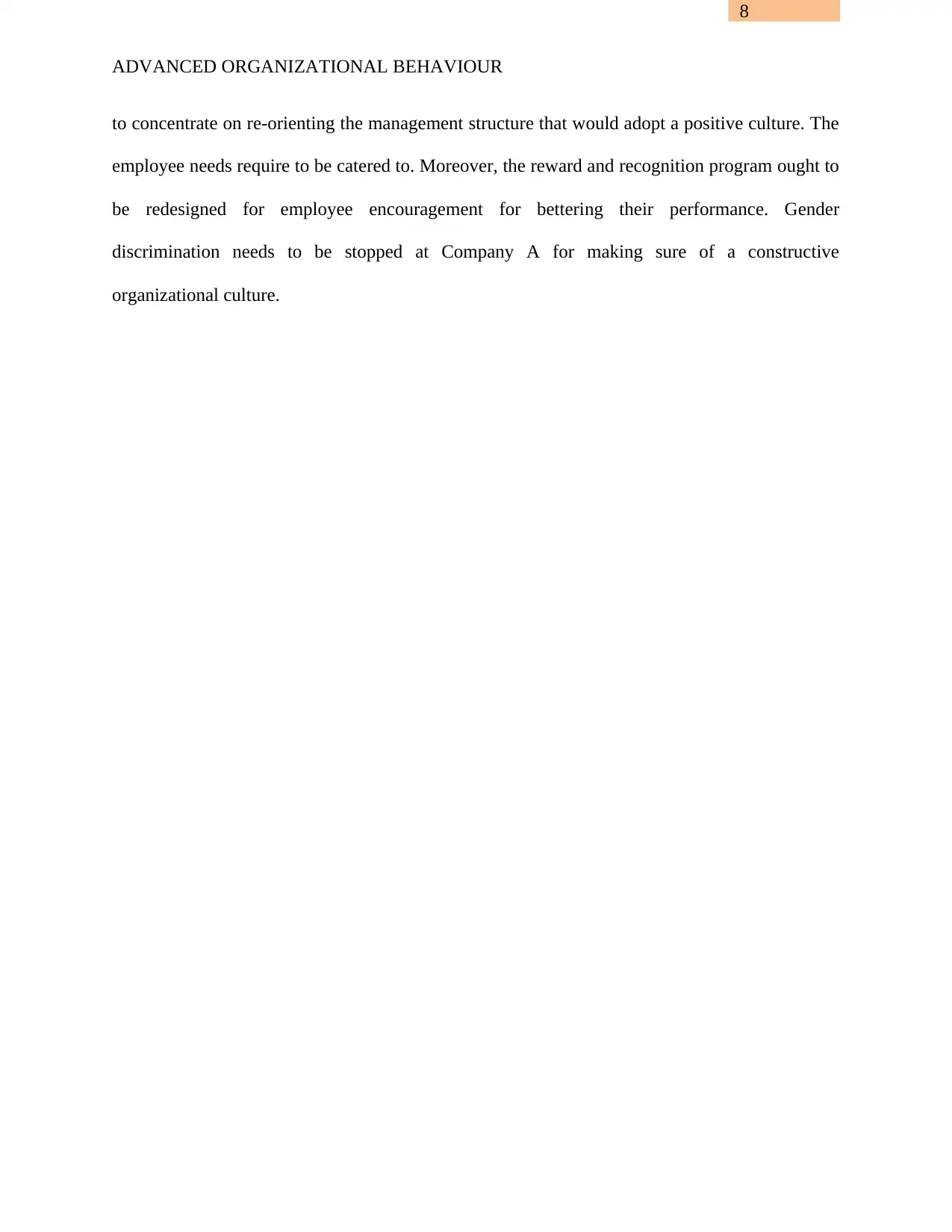
8
ADVANCED ORGANIZATIONAL BEHAVIOUR
to concentrate on re-orienting the management structure that would adopt a positive culture. The
employee needs require to be catered to. Moreover, the reward and recognition program ought to
be redesigned for employee encouragement for bettering their performance. Gender
discrimination needs to be stopped at Company A for making sure of a constructive
organizational culture.
ADVANCED ORGANIZATIONAL BEHAVIOUR
to concentrate on re-orienting the management structure that would adopt a positive culture. The
employee needs require to be catered to. Moreover, the reward and recognition program ought to
be redesigned for employee encouragement for bettering their performance. Gender
discrimination needs to be stopped at Company A for making sure of a constructive
organizational culture.
⊘ This is a preview!⊘
Do you want full access?
Subscribe today to unlock all pages.

Trusted by 1+ million students worldwide
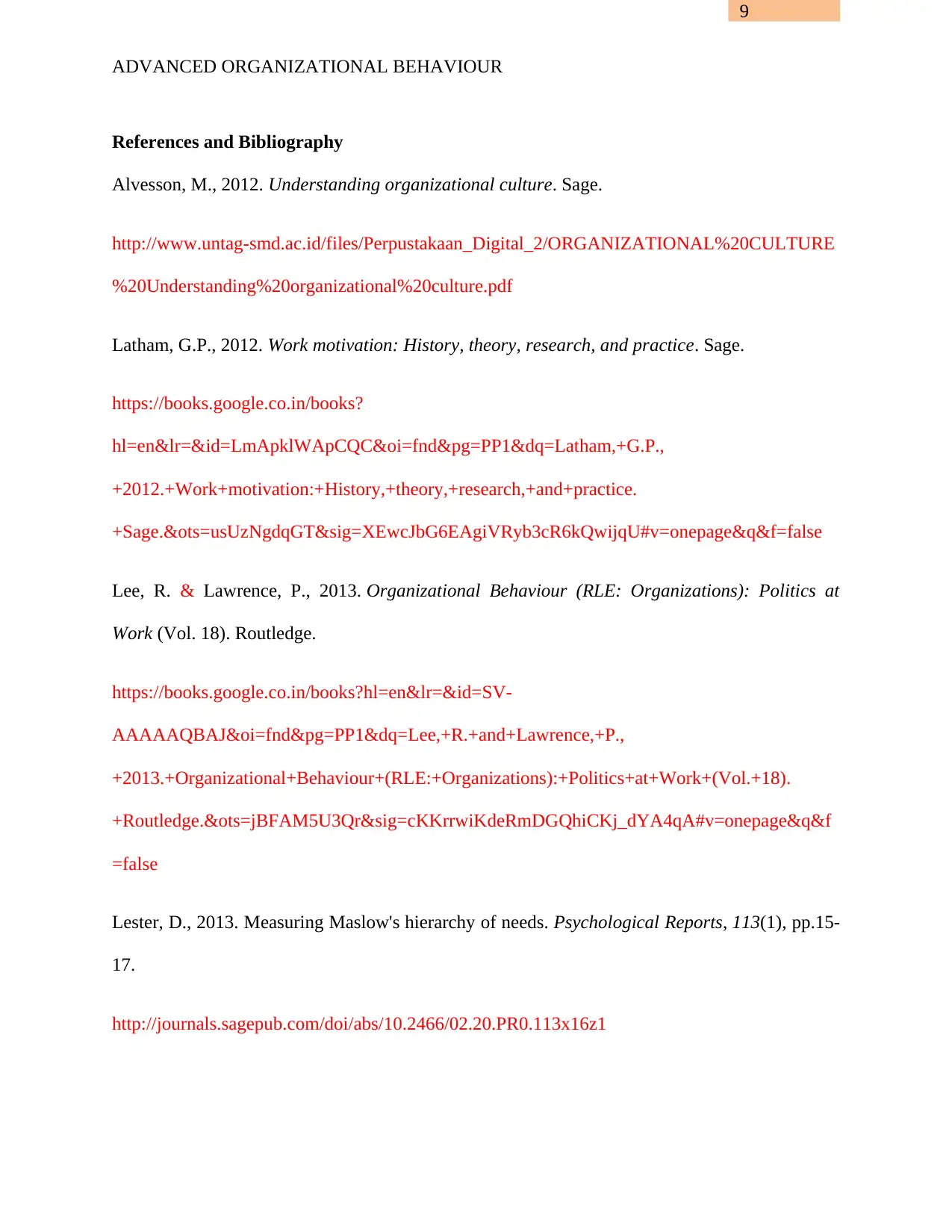
9
ADVANCED ORGANIZATIONAL BEHAVIOUR
References and Bibliography
Alvesson, M., 2012. Understanding organizational culture. Sage.
http://www.untag-smd.ac.id/files/Perpustakaan_Digital_2/ORGANIZATIONAL%20CULTURE
%20Understanding%20organizational%20culture.pdf
Latham, G.P., 2012. Work motivation: History, theory, research, and practice. Sage.
https://books.google.co.in/books?
hl=en&lr=&id=LmApklWApCQC&oi=fnd&pg=PP1&dq=Latham,+G.P.,
+2012.+Work+motivation:+History,+theory,+research,+and+practice.
+Sage.&ots=usUzNgdqGT&sig=XEwcJbG6EAgiVRyb3cR6kQwijqU#v=onepage&q&f=false
Lee, R. & Lawrence, P., 2013. Organizational Behaviour (RLE: Organizations): Politics at
Work (Vol. 18). Routledge.
https://books.google.co.in/books?hl=en&lr=&id=SV-
AAAAAQBAJ&oi=fnd&pg=PP1&dq=Lee,+R.+and+Lawrence,+P.,
+2013.+Organizational+Behaviour+(RLE:+Organizations):+Politics+at+Work+(Vol.+18).
+Routledge.&ots=jBFAM5U3Qr&sig=cKKrrwiKdeRmDGQhiCKj_dYA4qA#v=onepage&q&f
=false
Lester, D., 2013. Measuring Maslow's hierarchy of needs. Psychological Reports, 113(1), pp.15-
17.
http://journals.sagepub.com/doi/abs/10.2466/02.20.PR0.113x16z1
ADVANCED ORGANIZATIONAL BEHAVIOUR
References and Bibliography
Alvesson, M., 2012. Understanding organizational culture. Sage.
http://www.untag-smd.ac.id/files/Perpustakaan_Digital_2/ORGANIZATIONAL%20CULTURE
%20Understanding%20organizational%20culture.pdf
Latham, G.P., 2012. Work motivation: History, theory, research, and practice. Sage.
https://books.google.co.in/books?
hl=en&lr=&id=LmApklWApCQC&oi=fnd&pg=PP1&dq=Latham,+G.P.,
+2012.+Work+motivation:+History,+theory,+research,+and+practice.
+Sage.&ots=usUzNgdqGT&sig=XEwcJbG6EAgiVRyb3cR6kQwijqU#v=onepage&q&f=false
Lee, R. & Lawrence, P., 2013. Organizational Behaviour (RLE: Organizations): Politics at
Work (Vol. 18). Routledge.
https://books.google.co.in/books?hl=en&lr=&id=SV-
AAAAAQBAJ&oi=fnd&pg=PP1&dq=Lee,+R.+and+Lawrence,+P.,
+2013.+Organizational+Behaviour+(RLE:+Organizations):+Politics+at+Work+(Vol.+18).
+Routledge.&ots=jBFAM5U3Qr&sig=cKKrrwiKdeRmDGQhiCKj_dYA4qA#v=onepage&q&f
=false
Lester, D., 2013. Measuring Maslow's hierarchy of needs. Psychological Reports, 113(1), pp.15-
17.
http://journals.sagepub.com/doi/abs/10.2466/02.20.PR0.113x16z1
Paraphrase This Document
Need a fresh take? Get an instant paraphrase of this document with our AI Paraphraser
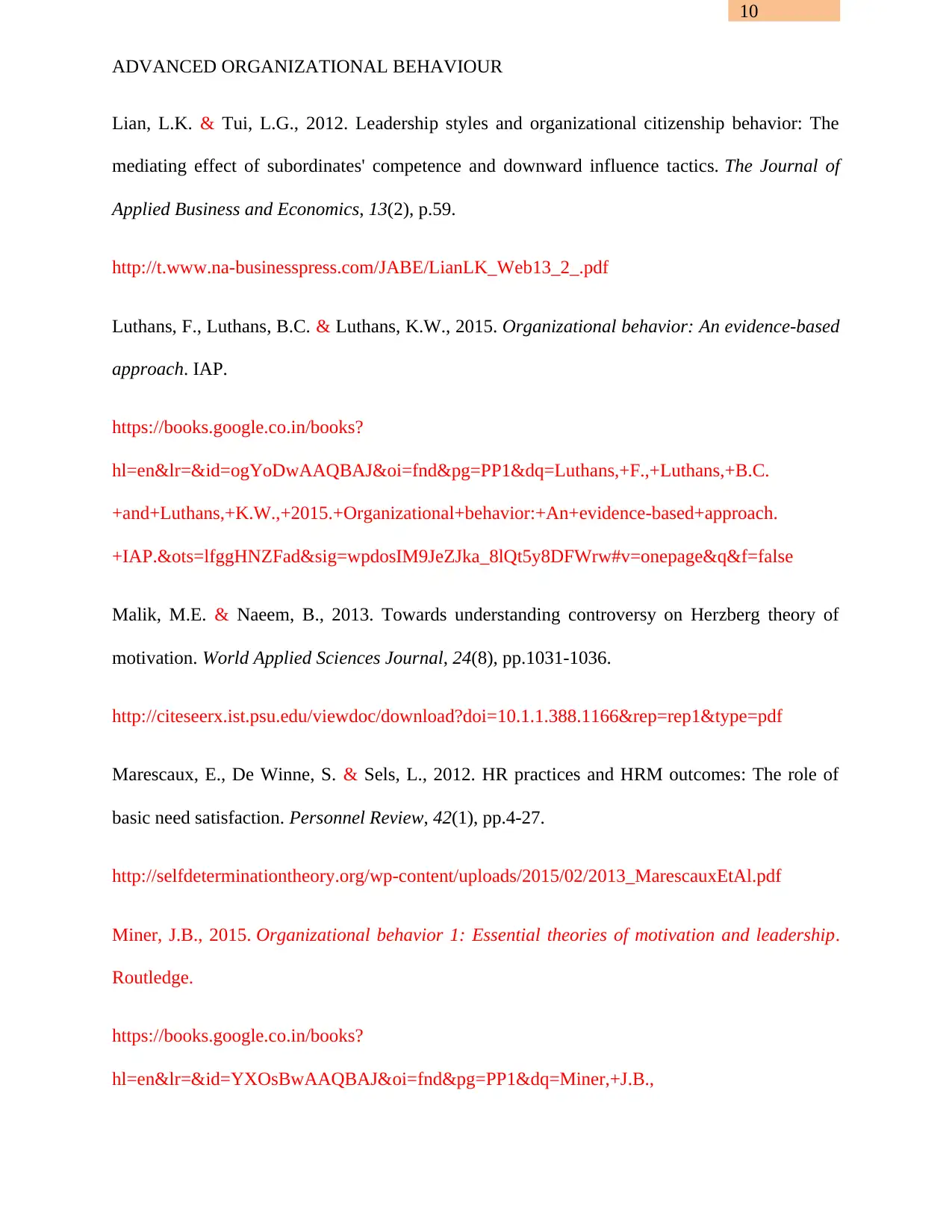
10
ADVANCED ORGANIZATIONAL BEHAVIOUR
Lian, L.K. & Tui, L.G., 2012. Leadership styles and organizational citizenship behavior: The
mediating effect of subordinates' competence and downward influence tactics. The Journal of
Applied Business and Economics, 13(2), p.59.
http://t.www.na-businesspress.com/JABE/LianLK_Web13_2_.pdf
Luthans, F., Luthans, B.C. & Luthans, K.W., 2015. Organizational behavior: An evidence-based
approach. IAP.
https://books.google.co.in/books?
hl=en&lr=&id=ogYoDwAAQBAJ&oi=fnd&pg=PP1&dq=Luthans,+F.,+Luthans,+B.C.
+and+Luthans,+K.W.,+2015.+Organizational+behavior:+An+evidence-based+approach.
+IAP.&ots=lfggHNZFad&sig=wpdosIM9JeZJka_8lQt5y8DFWrw#v=onepage&q&f=false
Malik, M.E. & Naeem, B., 2013. Towards understanding controversy on Herzberg theory of
motivation. World Applied Sciences Journal, 24(8), pp.1031-1036.
http://citeseerx.ist.psu.edu/viewdoc/download?doi=10.1.1.388.1166&rep=rep1&type=pdf
Marescaux, E., De Winne, S. & Sels, L., 2012. HR practices and HRM outcomes: The role of
basic need satisfaction. Personnel Review, 42(1), pp.4-27.
http://selfdeterminationtheory.org/wp-content/uploads/2015/02/2013_MarescauxEtAl.pdf
Miner, J.B., 2015. Organizational behavior 1: Essential theories of motivation and leadership.
Routledge.
https://books.google.co.in/books?
hl=en&lr=&id=YXOsBwAAQBAJ&oi=fnd&pg=PP1&dq=Miner,+J.B.,
ADVANCED ORGANIZATIONAL BEHAVIOUR
Lian, L.K. & Tui, L.G., 2012. Leadership styles and organizational citizenship behavior: The
mediating effect of subordinates' competence and downward influence tactics. The Journal of
Applied Business and Economics, 13(2), p.59.
http://t.www.na-businesspress.com/JABE/LianLK_Web13_2_.pdf
Luthans, F., Luthans, B.C. & Luthans, K.W., 2015. Organizational behavior: An evidence-based
approach. IAP.
https://books.google.co.in/books?
hl=en&lr=&id=ogYoDwAAQBAJ&oi=fnd&pg=PP1&dq=Luthans,+F.,+Luthans,+B.C.
+and+Luthans,+K.W.,+2015.+Organizational+behavior:+An+evidence-based+approach.
+IAP.&ots=lfggHNZFad&sig=wpdosIM9JeZJka_8lQt5y8DFWrw#v=onepage&q&f=false
Malik, M.E. & Naeem, B., 2013. Towards understanding controversy on Herzberg theory of
motivation. World Applied Sciences Journal, 24(8), pp.1031-1036.
http://citeseerx.ist.psu.edu/viewdoc/download?doi=10.1.1.388.1166&rep=rep1&type=pdf
Marescaux, E., De Winne, S. & Sels, L., 2012. HR practices and HRM outcomes: The role of
basic need satisfaction. Personnel Review, 42(1), pp.4-27.
http://selfdeterminationtheory.org/wp-content/uploads/2015/02/2013_MarescauxEtAl.pdf
Miner, J.B., 2015. Organizational behavior 1: Essential theories of motivation and leadership.
Routledge.
https://books.google.co.in/books?
hl=en&lr=&id=YXOsBwAAQBAJ&oi=fnd&pg=PP1&dq=Miner,+J.B.,
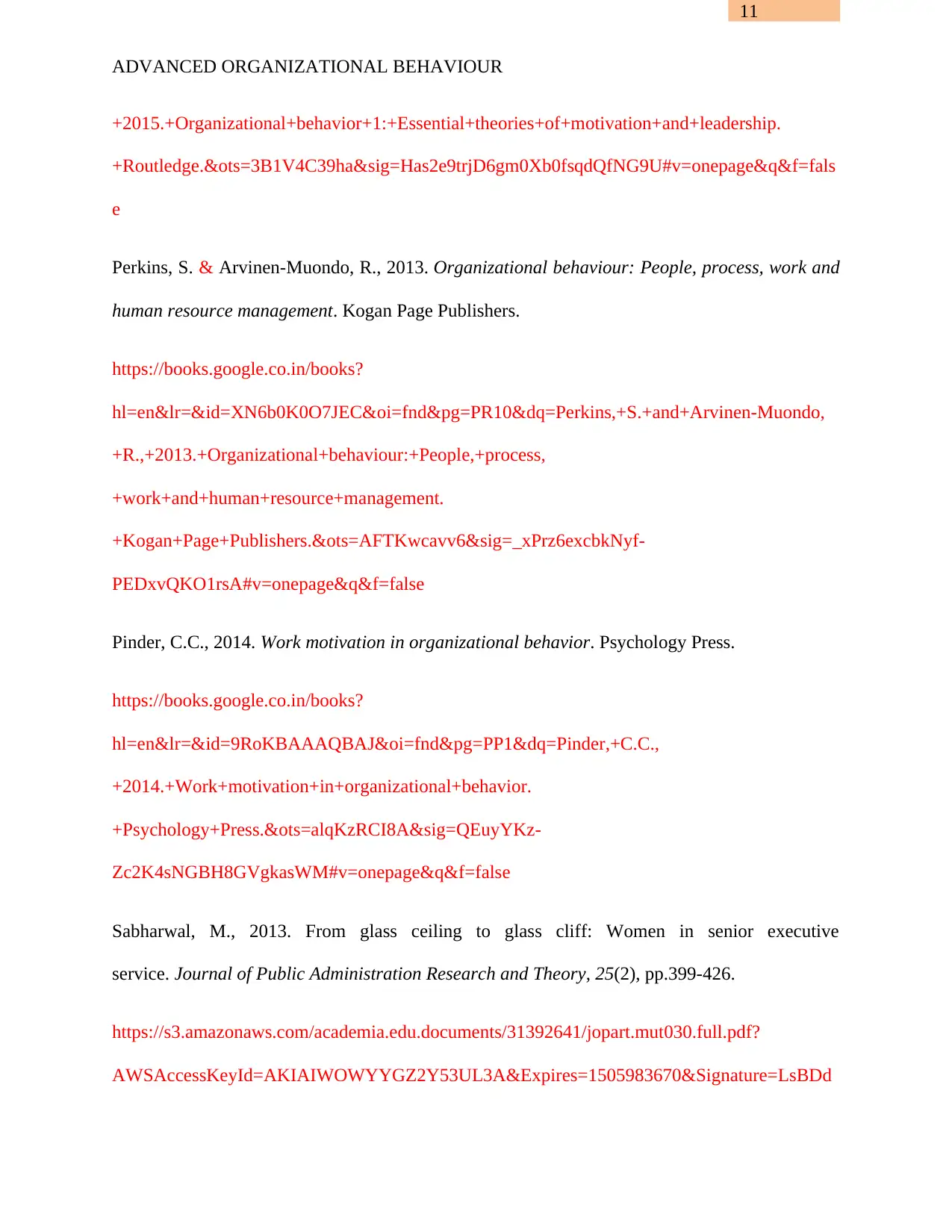
11
ADVANCED ORGANIZATIONAL BEHAVIOUR
+2015.+Organizational+behavior+1:+Essential+theories+of+motivation+and+leadership.
+Routledge.&ots=3B1V4C39ha&sig=Has2e9trjD6gm0Xb0fsqdQfNG9U#v=onepage&q&f=fals
e
Perkins, S. & Arvinen-Muondo, R., 2013. Organizational behaviour: People, process, work and
human resource management. Kogan Page Publishers.
https://books.google.co.in/books?
hl=en&lr=&id=XN6b0K0O7JEC&oi=fnd&pg=PR10&dq=Perkins,+S.+and+Arvinen-Muondo,
+R.,+2013.+Organizational+behaviour:+People,+process,
+work+and+human+resource+management.
+Kogan+Page+Publishers.&ots=AFTKwcavv6&sig=_xPrz6excbkNyf-
PEDxvQKO1rsA#v=onepage&q&f=false
Pinder, C.C., 2014. Work motivation in organizational behavior. Psychology Press.
https://books.google.co.in/books?
hl=en&lr=&id=9RoKBAAAQBAJ&oi=fnd&pg=PP1&dq=Pinder,+C.C.,
+2014.+Work+motivation+in+organizational+behavior.
+Psychology+Press.&ots=alqKzRCI8A&sig=QEuyYKz-
Zc2K4sNGBH8GVgkasWM#v=onepage&q&f=false
Sabharwal, M., 2013. From glass ceiling to glass cliff: Women in senior executive
service. Journal of Public Administration Research and Theory, 25(2), pp.399-426.
https://s3.amazonaws.com/academia.edu.documents/31392641/jopart.mut030.full.pdf?
AWSAccessKeyId=AKIAIWOWYYGZ2Y53UL3A&Expires=1505983670&Signature=LsBDd
ADVANCED ORGANIZATIONAL BEHAVIOUR
+2015.+Organizational+behavior+1:+Essential+theories+of+motivation+and+leadership.
+Routledge.&ots=3B1V4C39ha&sig=Has2e9trjD6gm0Xb0fsqdQfNG9U#v=onepage&q&f=fals
e
Perkins, S. & Arvinen-Muondo, R., 2013. Organizational behaviour: People, process, work and
human resource management. Kogan Page Publishers.
https://books.google.co.in/books?
hl=en&lr=&id=XN6b0K0O7JEC&oi=fnd&pg=PR10&dq=Perkins,+S.+and+Arvinen-Muondo,
+R.,+2013.+Organizational+behaviour:+People,+process,
+work+and+human+resource+management.
+Kogan+Page+Publishers.&ots=AFTKwcavv6&sig=_xPrz6excbkNyf-
PEDxvQKO1rsA#v=onepage&q&f=false
Pinder, C.C., 2014. Work motivation in organizational behavior. Psychology Press.
https://books.google.co.in/books?
hl=en&lr=&id=9RoKBAAAQBAJ&oi=fnd&pg=PP1&dq=Pinder,+C.C.,
+2014.+Work+motivation+in+organizational+behavior.
+Psychology+Press.&ots=alqKzRCI8A&sig=QEuyYKz-
Zc2K4sNGBH8GVgkasWM#v=onepage&q&f=false
Sabharwal, M., 2013. From glass ceiling to glass cliff: Women in senior executive
service. Journal of Public Administration Research and Theory, 25(2), pp.399-426.
https://s3.amazonaws.com/academia.edu.documents/31392641/jopart.mut030.full.pdf?
AWSAccessKeyId=AKIAIWOWYYGZ2Y53UL3A&Expires=1505983670&Signature=LsBDd
⊘ This is a preview!⊘
Do you want full access?
Subscribe today to unlock all pages.

Trusted by 1+ million students worldwide
1 out of 13
Related Documents
Your All-in-One AI-Powered Toolkit for Academic Success.
+13062052269
info@desklib.com
Available 24*7 on WhatsApp / Email
![[object Object]](/_next/static/media/star-bottom.7253800d.svg)
Unlock your academic potential
Copyright © 2020–2025 A2Z Services. All Rights Reserved. Developed and managed by ZUCOL.



